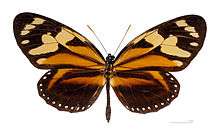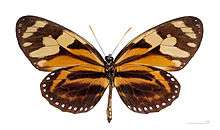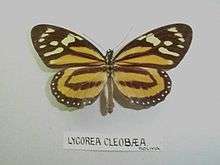Lycorea halia
Lycorea halia, the tropical milkweed butterfly (also known as tiger-mimic queen), is a species of nymphalid butterfly in the Danainae subfamily. It is found from Peru to the Caribbean[2] and Mexico. Strays can be found as far north as Texas. The habitat consists of rainforest.
| Tropical milkweed butterfly | |
|---|---|
 | |
| From MHNT | |
 | |
| Ventral view, same specimen | |
| Scientific classification | |
| Kingdom: | Animalia |
| Phylum: | Arthropoda |
| Class: | Insecta |
| Order: | Lepidoptera |
| Family: | Nymphalidae |
| Genus: | Lycorea |
| Species: | L. halia |
| Binomial name | |
| Lycorea halia | |
| Synonyms | |
| |
The wingspan is about 95–108 mm. Adults feed on bird droppings.
The larvae feed on Carica papaya, Ficus carica, Asclepias curassavica and Jacaratia.
Subspecies
- L. h. halia (Suriname, French Guiana)
- L. h. cleobaea (Godart, 1819) (Antilles, Dominican Republic)
- L. h. atergatis Doubleday, [1847] (Mexico to Venezuela, Colombia)
- L. h. pales C. & R. Felder, 1862 (Peru, Brazil (Acre))
- L. h. demeter C. & R. Felder, 1865 (Cuba)
- L. h. cinnamomea Weymer, 1883 (Brazil (Amazonas))
- L. h. discreta Haensch, 1909 (Brazil (Minas Gerais, Rio de Janeiro, Bahia))
- L. h. fasciata Haensch, 1909 (Ecuador)
- L. h. transiens Riley, 1919 (Brazil (Amazonas))
Gallery
 L. h. halia French Guiana
L. h. halia French Guiana- L. h. atergalis Colombia
 L. h. cleobaea
L. h. cleobaea
gollark: It's from Terrafreaky, as always.
gollark: I don't really care a huge amount, I just want a bit more variety.
gollark: Probably.
gollark: I mean, with a male, is the decision for it to be purple/green biome-based?
gollark: I know that part.
References
- "Lycorea Doubleday, [1847]" at Markku Savela's Lepidoptera and Some Other Life Forms
- Van-Wright, R.I.; Ackery, P.R.; Turner, T. (1992). "Anetia Jaegeri, Danaus Cleophile and Lycoriea cleobaea from Jamaica (Nymphalide: Danaine)". Journal of the Lepidopterists' Society. 46 (4): 273–279.
This article is issued from Wikipedia. The text is licensed under Creative Commons - Attribution - Sharealike. Additional terms may apply for the media files.